Detroit Lions film review: 10 observations vs. Bucs

Allen Park — Another weird week with a Saturday game has led to a schedule delay, but here are 10 observations from my film review of the Detroit Lions' victory over the Tampa Bay Buccaneers last Sunday.
One pick, two pick
The Lions defense held a turnover parade in Tampa, with two interceptions and three fumble recoveries. Let's first take a look at the two plays on which the Lions picked off quarterback Jameis Winston.
The first came early in the second quarter. On a second-and-9 play, the Bucs ran misdirection, faking a pitch to running back Peyton Barber going left with Winston rolling to his right, where he had three options flood that side of the field.
The Lions defense did a nice job on the play-fake, quickly recovering to crowd the passing lanes of Winston's two underneath targets, wide receiver Mike Evans and Adam Humphries coming across the formation. Winston opted to target deep option DeSean Jackson, running an out route at a depth of 16 yards. But because the quarterback threw on the move, he didn't get maximum drive on his throw, allowing cornerback Darius Slay to aggressively jump the route and secure his fifth interception of the year, a sliding grab right in front of the sideline.
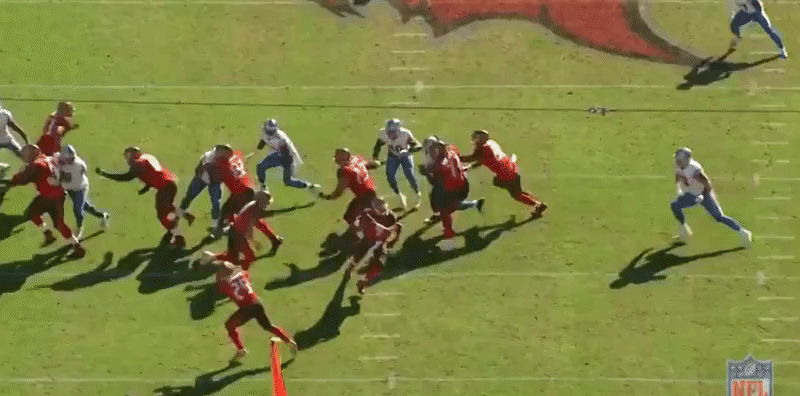
Winston's second interception had more to do with his own poor passing mechanics than anything. The Lions came with a blitz, sending two linebackers, but it didn't generate immediate pressure. Linebacker Tahir Whitehead did jam tight end O.J. Howard, the intended target, slowing him slightly. The pass sailed on Winston because he unnecessarily released off his back foot. The high throw went over Howard's head, directly into the waiting arms of Quandre Diggs, for his first career interception.
The Lions nearly came up with two additional interceptions. Slay made an impressive read, breaking off his man to tip a pass intended for Howard down the seam, but Jarrad Davis couldn't corral the deflection. On the other, pressure from defensive end Anthony Zettel forced Winston to bail from the pocket and overthrow running back Doug Martin. The errant pass sailed just beyond the fingertips of Whitehead, in zone coverage.
Art of forcing a fumble
Let's also look back at why the Lions were able to force three fumbles.
The first was simply outstanding timing by Diggs, playing the deep safety in a Cover-1. When Howard beat Glover Quin on a skinny post down the seam, Diggs lined up the receiver and delivered a jarring shoulder pad blow directly to the ball, just as the tight end established himself as a runner. It was such a bang-bang play, Diggs was initially flagged for hitting a defenseless receiver before instant replay exonerated him from the infraction.
In the third quarter, Davis forced Winston to fumble on a well-executed blitz. The Lions sent two linebackers, with Whitehead coming from the right edge, outside the defensive end, and Davis bringing off-line pressure up the middle. The rookie sliced between the left guard and tackle, where he was met by Barber, a 225-pound back, in the rush lane. But Davis plowed through, got an arm on Winston as he stepped up in the pocket and chopped the ball out as the quarterback tried to dump it to his tight end.
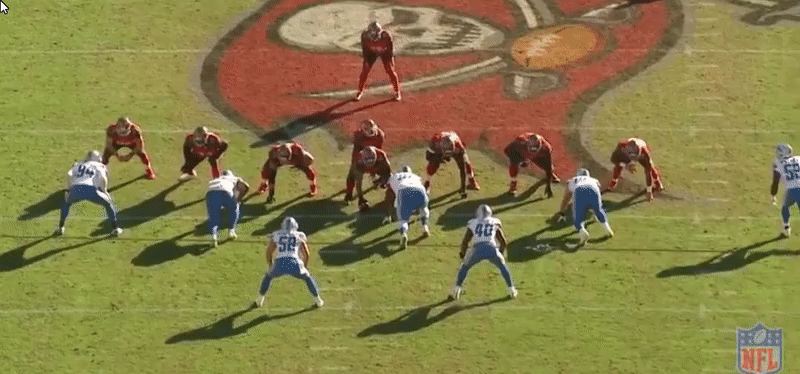
Quin also chopped a ball free, chasing down Martin from the backside. That entire play was set up by sound defense. The Bucs lined up in I-formation and looked to run Martin right behind his fullback, but the Lions quickly sealed all potential lanes to that side with Zettel getting strong push up front and Quin and the linebackers quickly flowing to the ball. Martin reversed field, but Tahir Whitehead set the edge on the backside, stringing the run out and allowing Quin to close from behind and make the play.

Stafford's errors
Quarterback Matthew Stafford had one of his better days this season throwing the football, making accurate throws at all levels, completing better than 80 percent of his attempts. But he made two big errors late in the first half and the Bucs turned those mistakes into turnovers.
On the first, Stafford lofted a deep ball to Kenny Golladay. Cornerback Brent Grimes had solid coverage but that wasn't necessarily a deterrent given the receiver's size advantage and ability to win one-on-one. But Stafford made the rare mistake of putting the ball into double-coverage. Tampa was in a Cover-2 look and the safety to Golladay's side never shaded toward Ebron in the slot, which put the defensive back in ideal position to provide Grimes help.
Not that Grimes needed help. The ball was slightly under-thrown, and the veteran cornerback with the impressive vertical went up to make a leaping grab. Worse yet, as Stafford acknowledged after the game, running back Theo Riddick was wide open underneath for a sizable gain.

Less than two minutes later, with time running out in the first half and the Lions already in field-goal range, Stafford forced another throw into coverage. The design had three receivers bunched in the left slot. Golladay ran a deep flag route, drawing double coverage. That left cornerback Robert McClain and linebacker Kwon Alexander to handle Golden Tate and Marvin Jones, running layered out routes.
Pressured from the pocket, Stafford targeted Tate, the deeper of the two options, with a mismatch against Alexander. But McClain never took his eyes out of the backfield and was able to drift back and make a play on the ball. The error took potential points off the board, when Stafford could have made the safer throw to Jones underneath or simply thrown it away.
Downhill Davis
This game was one of Davis' best performances, which is promising after a rocky rookie season. The linebacker is still being held off the field on some of the more obvious passing downs, but his gap integrity in run defense was on point much of the afternoon. He also had two critical pass rushes, one the aforementioned forced fumble, and another that generated an errant pass when the Lions had a blown coverage in the back end.
Watching Tampa Bay's middle linebacker Kwon Alexander play with strong instincts and angles, you get a true sense of what Davis can be once he fully develops.
Teez gets tested
The Lions had been slowly bringing second-round pick Teez Tabor along, working him 10-15 snaps as a nickel cornerback in recent games, but they thrust a much larger challenge on him against Tampa Bay, matching him up with Mike Evans, arguably one of the 10 best receivers in the NFL. Defensive coordinator Teryl Austin acknowledged he liked how Tabor's size matched up against the 6-foot-5 receiver.
It certainly wasn't a flawless performance, but Tabor held his own. The most impressive play came in the red zone, when the young corner denied a 5-yard fade into end zone, starting with a solid press coverage on the snap, then pinning the receiver's left arm as the ball arrived, preventing him from using both hands to secure the grab.
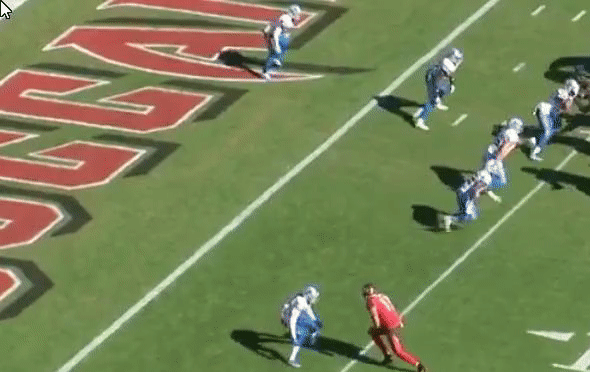
Learning on the fly
You can't ask for much more than two forced turnovers as Diggs continues his shift to safety, but the young defensive back's reaction time when playing deep is still a work in progress. His ability to read-and-react when defending the run or a screen was one of his defining traits as a slot corner, but he shows noticeably more hesitation when viewing the field from his perch as the deep safety.
That delayed reaction led to a handful of Bucs' runs and short passes gaining a few extra yards, particularly when Diggs missed back-to-back tackles on play-action passes at the end of the first half.
Even though he's been cross-training in practice for the role all season, the position switch carries a high-degree of difficulty. Diggs is ahead of the curve, and his ability to make big plays more than offsets the growing pains of playing in space.
Anticipatory delivery
We noted Stafford's two interceptions, forced into coverage, but I wanted to highlight two of his more impressive throws from the victory. First, the placement on his deep ball to Marvin Jones is the reason the play works.
Facing second-and-20, Jones runs a skinny post from wide left, angling between the cornerback and deep safety with the Bucs playing quarters coverage. Stafford fires just as Jones draws even with both defensive backs to his side. Because the safety is flipping his hips, Jones has him beat vertically. Stafford places the ball more toward the middle of the field so that Jones' inside position against the cornerback plays to the receiver's advantage. Jones slightly adjusts his angle at the end of the route and makes the 38-yard grab deep into the red zone.
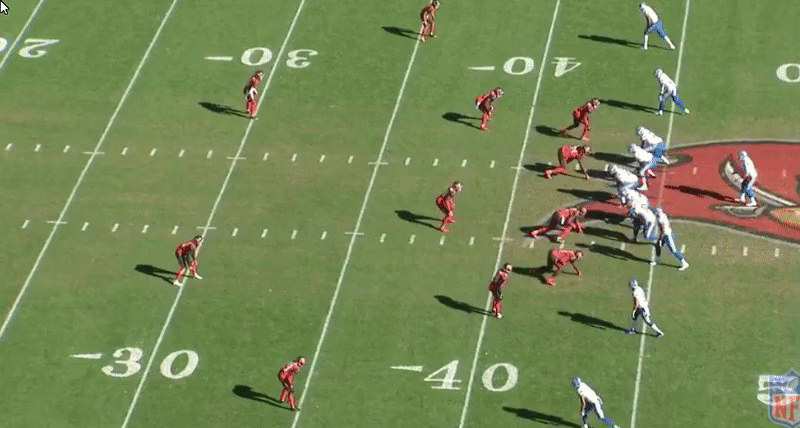
The second throw I wanted to highlight was wiped off the books by a holding call against Graham Glasgow. Still, the in-sync timing between quarterback and receiver is impressive.
Early fourth quarter, Lions need nine on third down and Tate runs a dig route from the right slot. Before he even gets out of his break at a depth of 10 yards, Stafford's arm is cocked. The ball hits Tate in stride, with separation and should have been a 26-yard gain had Glasgow not been forced to grab because he was beaten by the defensive tackle.
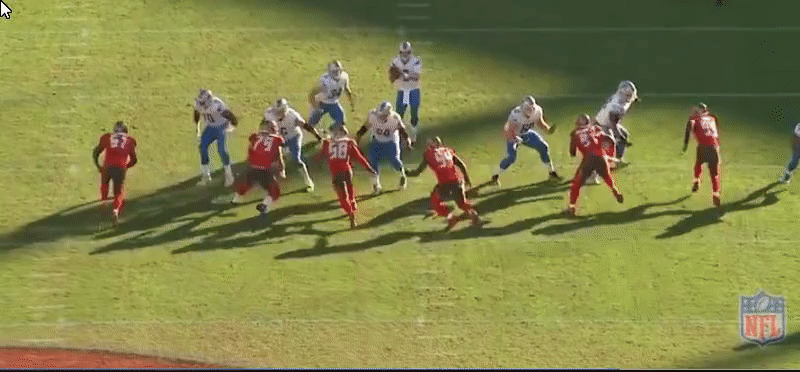
Game-saving tip
Sometimes, the little things go unnoticed, and while the broadcast picked it up, it's not something that wasn't caught live or in box score. On a critical third down late in the fourth quarter, with the score tied, the Bucs looked to set up a screen to Charles Sims. But the play was broken up behind the line of scrimmage when defensive end Cornelius Washington got his hands in the passing lane and fingertips on the throw, causing it to fall short of its intended target.
Whitehead was bearing down on the back, but who knows, maybe Sims slips the tackle and picks up the first down. With fewer than three minutes remaining and a fresh set downs near midfield, it could have been the difference in the game.
It's a trap
Tampa Bay had a lot of success running the ball, averaging 4.8 yards per carry. Much of that had to do with the ineffectiveness of Detroit's defensive tackles, who struggled to maintain their gaps when doubled. A'Shawn Robinson had a particularly rough day, consistently getting moved off his spot against the run.
Additionally, opponents have recently been successfully mixing in trap blocks, using the defensive linemen's aggressiveness against them by intentionally allowing them into the backfield. Robinson got fooled so badly on one that he went flying to the ground and was further prevented from impacting the play by a pulling guard delivering a wham block.
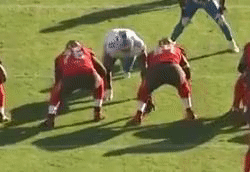
Play-action problems
The Lions got beat twice by the same play, a play-action pass design, near the goal line.
Detroit has been susceptible to play-action in the red zone much of the season and Sunday was no different. The team continues to make adjustments, this week having defensive end Kasim Edebali cover the tight end into the flat. On the first, a throw to Howard, Edebali's coverage was pretty good, but the defensive end who played some linebacker for Denver earlier in the year, still wasn't able to get in position to make a play on the ball.

On the second, Bucs coach Dirk Koetter acknowledged they noticed the backside tight end, eligible offensive tackle Leonard Wester, uncovered on the previous play-action touchdown and committed to throwing to him if they had another chance. It worked to perfection as Wester was left uncovered once again.
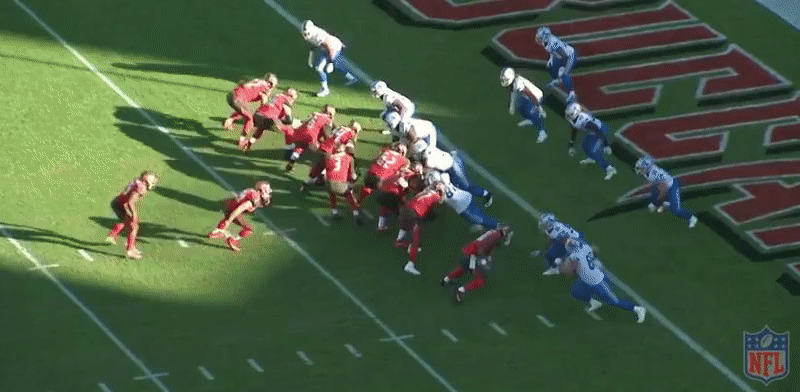
Austin is taking the blame for the play-action problems in the red zone, and the uncovered Wester does show a lack of emphasis on unexpected options in the pass game. But with the Howard score, it prompts the question whether the Lions have a defender on the roster capable of covering an athletic tight end on these plays.
jdrogers@detroitnews.com
twitter.com/justin_rogers